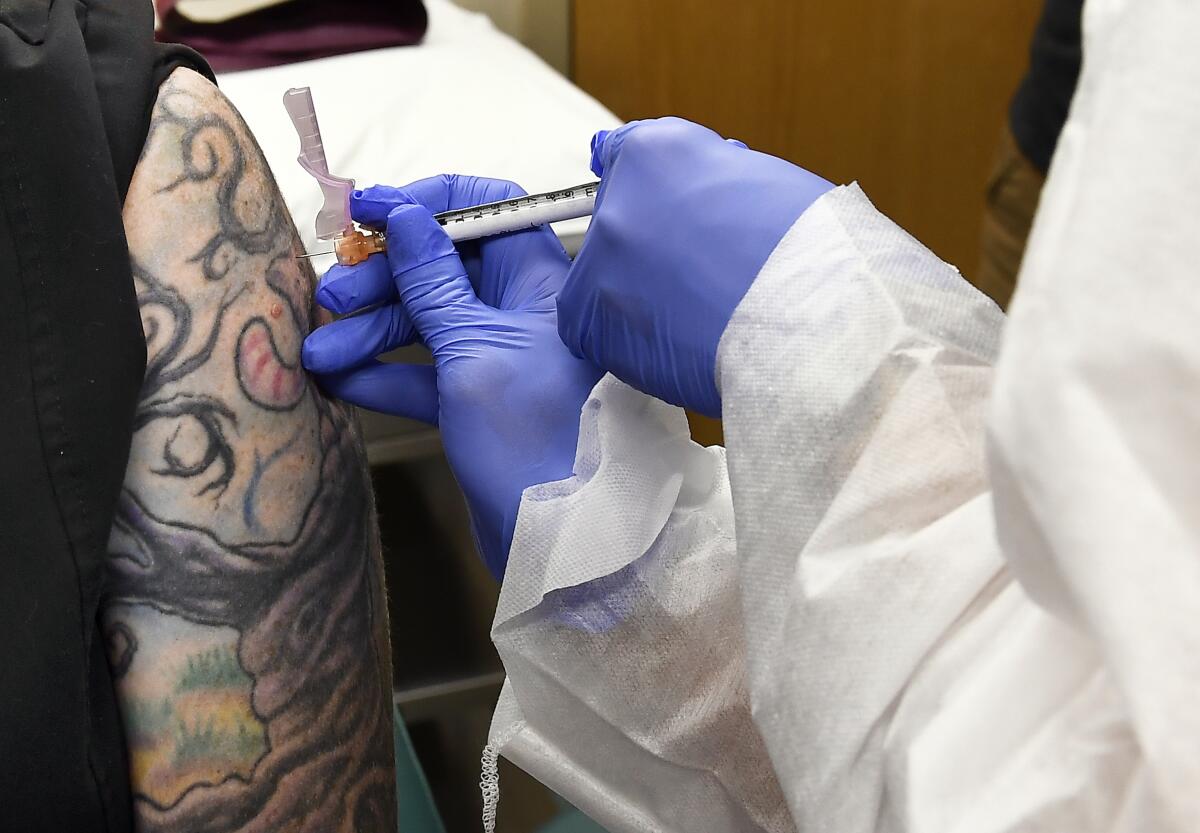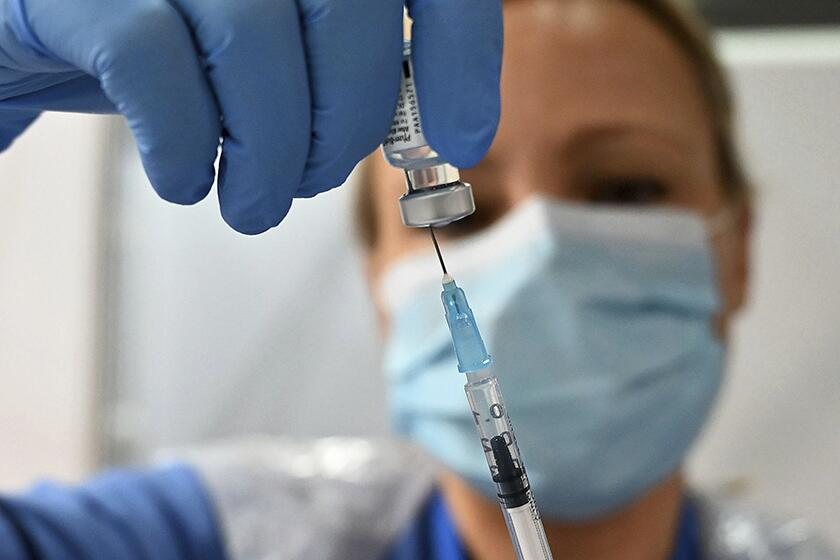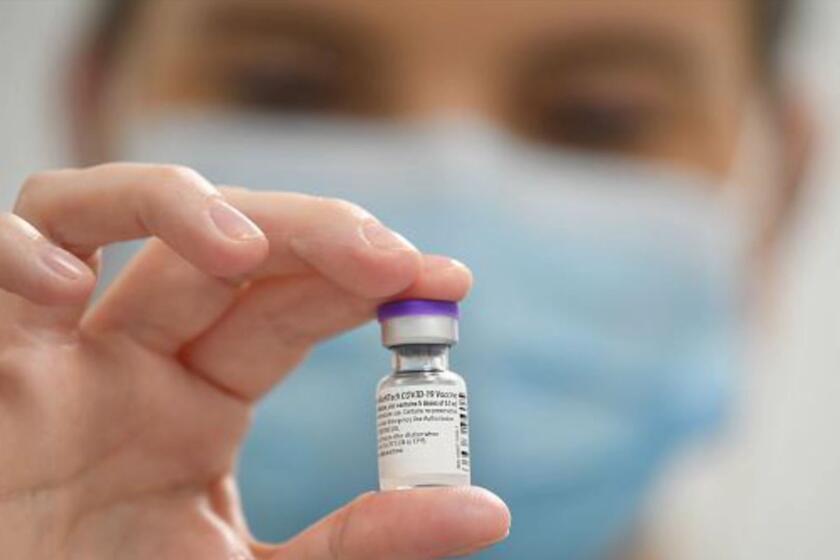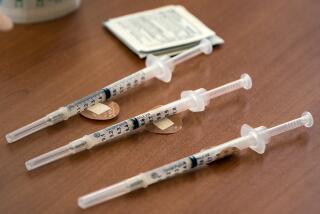How the COVID-19 vaccines from Moderna and Pfizer compare head to head

- Share via
If the COVID-19 vaccine from Pfizer and BioNTech was good enough to get a nod from the U.S. Food and Drug Administration, the vaccine from Moderna and the National Institutes of Health almost certainly is as well.
The FDA on Tuesday released its detailed analysis of the Moderna vaccine’s performance (so far) in an ongoing Phase 3 clinical trial involving more than 30,000 people. The bottom line: It was 94.5% effective at preventing cases of COVID-19.
An advisory group of independent scientists and other experts will pore over the data Thursday before voting on whether to recommend emergency use authorization for the Moderna vaccine. An endorsement would clear the way for FDA authorization within days.
A lot of things are different when you’re in the midst of a global pandemic. A case in point: How federal regulators scrutinize and authorize new vaccines.
Like the Pfizer vaccine, the Moderna vaccine primes the immune system to attack the coronavirus that causes COVID-19 by delivering a snippet of the virus’s genetic code. That code — known as messenger RNA, or mRNA — instructs the body to build copies of the spike protein that studs the virus’ surface. The immune system responds by creating antibodies, which remain on standby until confronted by an actual infection.
Here’s a closer look at how the two vaccines stack up:
How effective are the vaccines overall?
The Moderna vaccine was 94.5% effective in preventing COVID-19 among those who were tracked for a median of seven weeks after their second dose. Five of the 13,934 study participants who received the vaccine developed COVID-19, compared with 90 of the 13,883 participants who received the placebo.
The Pfizer vaccine was 95% effective in preventing COVID-19 among those who were tracked for a median of two months after getting their second dose. Eight of the 18,198 study participants who received the vaccine developed COVID-19, compared with 162 of the 18,325 participants who got the placebo.
Were the vaccines effective in older people?
Yes.
In its Phase 3 trial, the Moderna vaccine was 100% effective in people ages 65 and up. It was also 93.4% effective in people between the ages of 18 and 64.
In its Phase 3 trial, the Pfizer vaccine was 93.7% effective in people ages 56 and up. It was also 95.6% effective in people between the ages of 16 and 55.
How well did the vaccines work in people with preexisting medical conditions?
Both vaccines performed slightly better among people who had preexisting conditions that make them more vulnerable to COVID-19 than in people without them.
The Moderna vaccine was 95.9% effective in people with a select group of health issues — chronic lung disease, significant cardiac disease, diabetes, liver disease, HIV and severe obesity. For people without these conditions, it was 94% effective.
The Pfizer vaccine was 95.3% effective in people with a wider range of health issues and 94.7% effective in people without them. In addition to the health problems considered in the Moderna trial, the Pfizer trial also examined the vaccine’s performance in people with cancer, kidney disease, dementia and vascular disease, among other ailments.
Did the vaccines help people of color?
All five of the people in the Moderna trial who developed COVID-19 after receiving the vaccine were white. As a result, the Moderna vaccine was 100% effective in Black, Latino and Asian Americans, as well as in people with mixed racial backgrounds. Vaccine efficacy could not be determined for Native Americans or Pacific Islanders because there were no cases of COVID-19 in either the vaccine or the placebo groups.
In its Phase 3 trial, the Pfizer vaccine was 100% effective for Black study participants and 94.5% effective for Latino participants, slightly below the 94.7% effectiveness for white subjects. In addition, it was 74.4% effective in Asian Americans, and 100% effective in Native Americans and Pacific Islanders. Among people described as multiracial, it was only 10.4% effective, with one case of COVID-19 among those who got the vaccine and one case among those who got the placebo.
When people talk about COVID-19 vaccines, they can sound like they’re speaking a foreign language. Don’t worry! Here’s your guide to vaccine vocabulary.
Did the vaccines work equally well in men and women?
Both vaccines performed slightly better in men than in women.
The Moderna vaccine was 95.5% effective in men and 93.5% effective in women.
The Pfizer vaccine was 95.3% effective in men and 93.9% effective in women.
Did the vaccines prevent severe cases of COVID-19?
The Moderna vaccine was 100% effective at preventing cases of severe COVID-19. Eleven people in the trial developed severe disease, and all of them were in the group that received the placebo. Three of those patients were sick enough to be admitted to a hospital.
The Pfizer vaccine was 66.4% effective at preventing cases of severe COVID-19. Of the four study participants who developed severe illnesses after receiving two shots, one had gotten the vaccine and three got the placebo. Two of those in the placebo group were hospitalized, including one who was admitted to an intensive care unit.
What about side effects?
Neither vaccine caused problems that would make emergency use authorization unwarranted, the FDA analysis showed.
Short-term pain at the injection site was extremely common with both vaccines. Roughly 90% of those who got the Moderna vaccine reported such pain after their two doses, as did roughly 80% of those who got the Pfizer vaccine. In both trials, injection-site pain was far less common for people who received the placebo.
How to sign up for CA Notify
CA Notify, California’s smartphone-based COVID-19 exposure alert system, will only be effective if a lot of people sign up for it. Here’s how to opt in:
The most common side effects for both vaccines were fatigue, headache, muscle pain, chills and joint pain. However, these were reported more often in the Moderna trial than the Pfizer trial.
For instance, after receiving a second dose of the Moderna vaccine, 63% of study participants had a headache, 68% experienced fatigue, 45% had joint pain and 48% had chills.
In the Pfizer trial, 39% of participants had a headache, 51% experienced fatigue, 19% had joint pain and 23% had chills after receiving their second dose of vaccine.









